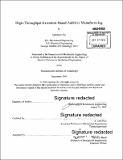High-throughput extrusion-based additive manufacturing
Author(s)
Go, Jamison
DownloadFull printable version (32.03Mb)
Alternative title
High-throughput extrusion-based AM
Other Contributors
Massachusetts Institute of Technology. Department of Mechanical Engineering.
Advisor
A. John Hart.
Terms of use
Metadata
Show full item recordAbstract
Additive manufacturing (AM), the process of building objects layer by layer from a three dimensional digital model, is gaining significance due to its ability to create unique geometries and/or novel material compositions while spanning a wide range of length scales. However, the viability of using AM for the production of end-use parts hinges on improvements to production speed without making sacrifices to quality. This thesis seeks to understand the rate-limits to extrusion-based AM, commonly referred to as fused deposition modeling (FDM), and to demonstrate this understanding via the design and fabrication of a high-throughput extrusion AM platform. Three subsystems - the pinch wheel extruder, the conduction liquefier, and the open loop series gantry - were identified as rate limiting to conventional FDM systems via module level experimentation and analysis. These limitations motivated the development of three alternate mechanisms -a screw-feed extruder, a laser-heated extruder, and H-frame gantry - which are designed to overcome the limitations of conventional techniques. These mechanisms are combined into a high-throughput desktop-scale prototype, called FastFDM. Using the FastFDM system, test parts are fabricated at twice the material deposition rate of state-of-the-art machines while maintaining comparable accuracy and resolution. The FastFDM approach has promising future applications to the extrusion AM of nanocomposite polymer resins, high-throughput AM of high performance thermoplastics, and adaptation to large-scale extrusion AM systems.
Description
Thesis: S.M., Massachusetts Institute of Technology, Department of Mechanical Engineering, 2015. Cataloged from PDF version of thesis. Includes bibliographical references (pages 171-179).
Date issued
2015Department
Massachusetts Institute of Technology. Department of Mechanical EngineeringPublisher
Massachusetts Institute of Technology
Keywords
Mechanical Engineering.